
Pictured Above: Photo of the Baba Saheb Shrine in Arghandab District. The caption, created by the District Governor, reads “One Arghandab…One People
Given the imminent downsizing of NATO forces in Afghanistan, many regions continue to wrestle with the concept of placing Afghanistan’s security forces into the lead. While having the Afghan security forces assume primary responsibility for security operations should occur within the natural progression of a counter-insurgency campaign, a few of our leaders and Soldiers continue to wrestle with the concept that placing Afghans in the lead along all lines of operation is paramount to our success. They fail to understand that “Afghan led” is the beginning of transition at the tactical level. Others continue to wrestle with ‘how’ to place them at the forefront of our counterinsurgency efforts. We ‘partner’ with them…sending a few of them on patrol with our forces while we actually drive the counterinsurgency fight. We ‘enable’ them by providing nearly every resource we have at our disposal. However, these types of efforts do little to truly place the Afghans at the forefront of this tough fight. Because our military formations are typically ill suited to deal with establishing a government, we challenge them to lead governance efforts with little to no support other than a Department of State representative as an advisor. “Afghan Led” is not a bumper sticker or an IO message. “Afghan Led” is a critical aspect of our counterinsurgency operations that we must grasp to enable ultimate mission success. It must happen along all lines of effort in a synchronized manner in order to set the conditions for enduring stability.
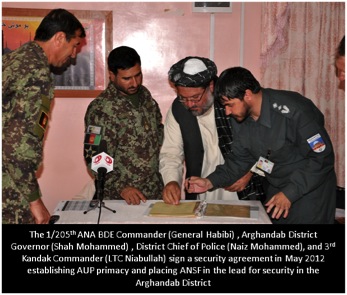 On 8 May, 2012 leaders of the Arghandab District signed a formal, public agreement announcing that the Afghan security forces were assuming primary responsibility for all security in the district. While not an official transition, this step marked an important move towards transition that will place the Afghan Uniformed Police, Afghan Local Police, and the Afghan National Army at the forefront of security efforts while ISAF assumes a supporting role to combat remaining challenges. Overall, the construct agreed to garrison police into 11 different regions throughout the District, stating, “the AUP has primacy on security, enforcing the Rule of Law, and having the capacity to deal with local security threats.” Furthermore, they may be enabled by other ANSF forces, but the primary responsibility resides with the permanent AUP garrisoned in the District. Both the Afghan National Army and the ISAF forces in the region agreed to support the AUP in all efforts to maintain security. Overall, this agreement wasn’t the result of happenstance. It resulted from nearly a year of blood and sweat to win over the people of the District. It resulted from a year’s worth of diligent training for the Afghan Security Forces. It resulted from a year’s worth of effort to enable the Afghans to finally take the lead during the 2012 fighting season, with ISAF still providing over-watch. It resulted from the commitment of a combined team that understood that “Afghan led” is much more than just an IO campaign. “Afghan led” is a critical step taken at the tactical level to enable eventually transition of all governance and security responsibilities to the Afghans.
On 8 May, 2012 leaders of the Arghandab District signed a formal, public agreement announcing that the Afghan security forces were assuming primary responsibility for all security in the district. While not an official transition, this step marked an important move towards transition that will place the Afghan Uniformed Police, Afghan Local Police, and the Afghan National Army at the forefront of security efforts while ISAF assumes a supporting role to combat remaining challenges. Overall, the construct agreed to garrison police into 11 different regions throughout the District, stating, “the AUP has primacy on security, enforcing the Rule of Law, and having the capacity to deal with local security threats.” Furthermore, they may be enabled by other ANSF forces, but the primary responsibility resides with the permanent AUP garrisoned in the District. Both the Afghan National Army and the ISAF forces in the region agreed to support the AUP in all efforts to maintain security. Overall, this agreement wasn’t the result of happenstance. It resulted from nearly a year of blood and sweat to win over the people of the District. It resulted from a year’s worth of diligent training for the Afghan Security Forces. It resulted from a year’s worth of effort to enable the Afghans to finally take the lead during the 2012 fighting season, with ISAF still providing over-watch. It resulted from the commitment of a combined team that understood that “Afghan led” is much more than just an IO campaign. “Afghan led” is a critical step taken at the tactical level to enable eventually transition of all governance and security responsibilities to the Afghans.
Thanks to the efforts of numerous organizations over the past two years (ISAF, DOS, USAID, SOF, etc), Arghandab District in Khandahar Province today serves as a good example where “Afghan led” has actually taken hold – sometimes in unexpected ways. In 2010, previous ISAF units surged into the area and conducted intense clearance operations in order to uproot the insurgent stronghold on the District. While insurgents remained in the area, the reduced levels of violence indicated that a transition of security responsibilities should take place in order to establish the conditions for sustainable security. In May 2011, CTF 1-67 AR found itself confronted with the challenge of improving security while simultaneously empowering the Afghan security forces to assume primary responsibility for security throughout the District. During our journey, we developed a comprehensive campaign plan that 1) continued to improve security in the Arghandab District, 2) placed the responsibility for security on the Afghans and, at the same time, 3) enabled true governance to take hold at the District and local level. The following portrays the general methodology used by CTF 1-67 to “Enable the Afghans to Take the Lead.” Many currently wrestling with this challenge will read this article looking for specifics steps that must be taken. To that, we can only say…skip to the last paragraph and save yourself the trouble.
“Afghan Led” is a Natural Part of Transition in a COIN Campaign: First and foremost, transition is the natural outcome of a realistic counter-insurgency campaign. Unless we intend to remain in Afghanistan indefinitely, enabling the ANSF to transition to the forefront is simply a process that must occur at some point in order to implement a system the host nation can sustain independently. When we first arrived in theater in June 2011, two US Battalions and two Afghan Army Battalions garrisoned the battlespace together along with nearly 400 Afghan Uniform Police and 150 Afghan Local Police. Enemy initiated attacks averaged one per day, and at the height of the fighting season in 2011, Arghandab District saw over 50 enemy initiated activities per month. While greatly reduced from the previous year (approximately a 75% reduction from the surge of 2009), the ultimate question of how to begin the transition process remained unanswered. How could ISAF withdraw forces from the area without the increase of Afghan security forces, and hope to maintain security in the region? The answer, surprisingly, was resident in our Afghan partners all along.
Regardless of What You Call It, This is Still a Population Centric COIN Fight: Anyone who has studied counter-insurgency operations understands that they always come down to a contest for the loyalty of the local population. The COIN fight in the Arghandab was no different. In fact, when CTF 1-67 AR assumed responsibility for the Arghandab District, the security situation remained extremely fragile…capable of easily slipping back into insurgent hands. Therefore, the primary challenge faced by units as we pushed Afghan security forces to the forefront as ISAF downsized, was to maintain the popular approval of pro-GIRoA elements, while simultaneously continuing to campaign for the approval of anti-GIRoA elements. This argument implies that three rules must be followed first and foremost as you push Afghans to the forefront for eventual transition.
-
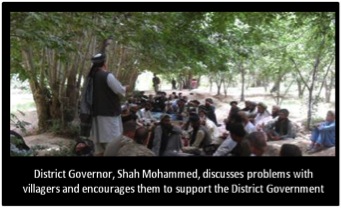 Your primary focus must continue to be on understanding and helping settle the grievances of the local population. You must understand why non-supportive influencers continue to invade the Afghan government, and then you must do your utmost to address those grievances. Within the Arghandab, we learned this by studying the history of the area, mapping the human terrain, and by heavily engaging local leaders in order to develop a deep appreciation for the problems local elders had with GIRoA. Past wrongdoings on the part of security and government officials; the loss or detention of family members; longstanding tribal (or Russian era mujahideen) rivalries; and land/water disputes; constituted the key grievances pushing the local populace away from the local government and from Afghan security forces. Until we understood these problems down to (and sometimes below) the village level, formulating a strategy for building popular support proved difficult. However, once we understood what the local populace truly believed, building strategies to address their grievances became far less complex.
Your primary focus must continue to be on understanding and helping settle the grievances of the local population. You must understand why non-supportive influencers continue to invade the Afghan government, and then you must do your utmost to address those grievances. Within the Arghandab, we learned this by studying the history of the area, mapping the human terrain, and by heavily engaging local leaders in order to develop a deep appreciation for the problems local elders had with GIRoA. Past wrongdoings on the part of security and government officials; the loss or detention of family members; longstanding tribal (or Russian era mujahideen) rivalries; and land/water disputes; constituted the key grievances pushing the local populace away from the local government and from Afghan security forces. Until we understood these problems down to (and sometimes below) the village level, formulating a strategy for building popular support proved difficult. However, once we understood what the local populace truly believed, building strategies to address their grievances became far less complex.
-
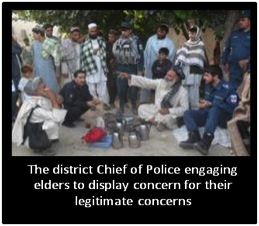 In the battle for the populace, as you place more responsibility on the Afghan Security Forces, the involvement of local government officials becomes paramount. In order to convince key influencers to support the government, the introduction of the government to the population must occur. Many areas of Afghanistan have difficulty with this concept due to ineffective District Governors, incompetent District Chiefs of Police, or other corrupt officials. In Arghandab District, we were lucky in this respect. The District Governor understood the importance of engaging the population routinely. The District Chief of Police also understood that the relationship between his police and the local citizens would ultimately determine the success or failure of the district’s enduring security apparatus. Engagement of village leaders became the primary focus of the District Governor. Professionalization of the police force - and improving its relationship with the local populace - became the primary area of emphasis for the District Chief of Police. Without a supportive and inclusive approach by our partners, all other transition efforts would have been at risk of failure.
In the battle for the populace, as you place more responsibility on the Afghan Security Forces, the involvement of local government officials becomes paramount. In order to convince key influencers to support the government, the introduction of the government to the population must occur. Many areas of Afghanistan have difficulty with this concept due to ineffective District Governors, incompetent District Chiefs of Police, or other corrupt officials. In Arghandab District, we were lucky in this respect. The District Governor understood the importance of engaging the population routinely. The District Chief of Police also understood that the relationship between his police and the local citizens would ultimately determine the success or failure of the district’s enduring security apparatus. Engagement of village leaders became the primary focus of the District Governor. Professionalization of the police force - and improving its relationship with the local populace - became the primary area of emphasis for the District Chief of Police. Without a supportive and inclusive approach by our partners, all other transition efforts would have been at risk of failure.
- Focus on letting the basics drive your operations. Once we began to understand the people, and we had the support of our Afghan partners, we focused on four basic tenants that drove all operations. Again, if you are looking for the specific “how” we did this, then skip to the last paragraph. Every village…every region of the Arghandab District faced different challenges that Afghan leaders needed to overcome.
-
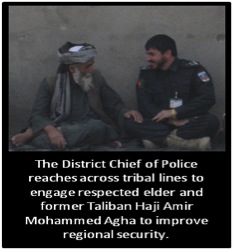 Foster a sustainable system of Government at the local level – Does one village have one malik? Does a malik represent multiple villages? If a village doesn’t have a malik but has a key influencer at the District level, does it even need one? The answers are “sometimes, sometimes, and maybe not.” There is no clear cut answer when you get down to the local level. Develop a solution that makes the local citizens happy and then support their efforts to tie into the District. Do not try to create cookie cutter solutions. Our system revolved around the configuration of 72 villages divided into 31 sub-Districts (consisting of clusters of villages aligned along human terrain lines, arranged into 11 police sub-garrisons, and all tied into a District Government that welcomed the participation of all parties.
Foster a sustainable system of Government at the local level – Does one village have one malik? Does a malik represent multiple villages? If a village doesn’t have a malik but has a key influencer at the District level, does it even need one? The answers are “sometimes, sometimes, and maybe not.” There is no clear cut answer when you get down to the local level. Develop a solution that makes the local citizens happy and then support their efforts to tie into the District. Do not try to create cookie cutter solutions. Our system revolved around the configuration of 72 villages divided into 31 sub-Districts (consisting of clusters of villages aligned along human terrain lines, arranged into 11 police sub-garrisons, and all tied into a District Government that welcomed the participation of all parties.
- Enable the Afghans to settle local grievances. We settled zero land disputes during our tour. We settled zero irrigation arguments. We settled no differences among tribes. We didn’t even re-integrate a single Taliban. However, the Battalion constantly found itself influencing the conditions necessary to force a resolution, or else found itself bringing in key arbitrators to enable the Afghans to come to their own solutions regarding local grievances. In a single year, the Battalion hosted over 600 shuras throughout the District at every level and in nearly every key location in the District.
-
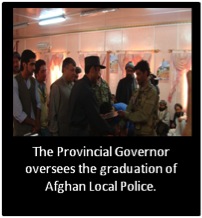 Enable the population to protect itself. If the population gets along, and they have no internal problems, then they should be able to protect themselves from the threat of INS influence. However, if they couldn’t, we supported the establishment of Afghan Local Police within the area. If the population united to the point that they elected local Afghans to protect their village and they were willing to send them through a training program, we supported them.
Enable the population to protect itself. If the population gets along, and they have no internal problems, then they should be able to protect themselves from the threat of INS influence. However, if they couldn’t, we supported the establishment of Afghan Local Police within the area. If the population united to the point that they elected local Afghans to protect their village and they were willing to send them through a training program, we supported them.
- Where the population can’t protect itself, enable the Afghan security forces. When the local population couldn’t protect itself; remained divided; or continued to experience unrest due to Taliban influence, Afghan security forces stepped up. Afghan police were pushed into nearly every region of the District and even more so to the areas that remained the most politically divided. When the Afghan police could not man all required areas, the Afghan National Army filled in the gaps.
After 30 years of war, most rural Afghans have no idea what a government should actually do for them. They have lived their entire lives along tribal lines, convinced that other tribes, villages, or areas immediately surrounding them are the root of all problems they face daily. After determining a basis for what we wanted “Afghan Led” to look like, establishing the mechanisms that allow people to communicate with their government routinely became our primary mission. The network of village shuras, led by Afghan leaders and village elders, became the framework for communication with the District at the village level. At the District level, this inclusive approach to District level shuras became the norm. The District Governor adopted “One Arghandab…One People” as the motto for the District. Anyone who had a grievance could attend District level shuras. The Governor made routine visits to villages to gauge the sentiments of the local population, paying particular attention to disaffected villages. These communication mechanisms enabled the political process to begin with an Afghan leader at the forefront.
Even as You Put Afghanis in the Lead, the Most Important Task Remains the Security of the Population. Transitioning while insurgent activity continues is entirely possible. In the Arghandab, with over 30 enemy actions per month, the transition of Afghans into the lead began to occur regardless. Nine ISAF Companies were reduced to four. Two Afghan National Army Battalions were reduced to one. However, this withdrawal of forces was only possible because the remaining forces relentlessly pursued the enemy throughout the district. Seven kinetic strike operations effectively destroyed numerous IED cells. Relentless and focused targeting operations forced most insurgent leaders out of the District. Three partnered patrols per platoon per day disrupted insurgent activity to the point of ineffectiveness. Over 100 ANSF-led clearance operations took away every enemy sanctuary in the District. Engagements between the Afghan National Security Forces and the local populace created an informant network that denied the enemy a place to hide. In April 2012, one of the last long- standing insurgent leaders of the District was killed as a result of a Special Forces operation. He died with four other insurgents – in a tent - one kilometer away from the nearest house, on the very northern edge of the District, miles away from any significant population center. Those conditions speak volumes about the effect security operations had on the insurgents over time – it wasn’t their home turf anymore. It was GIRoA’s, and they had to fight to even infiltrate the population again.
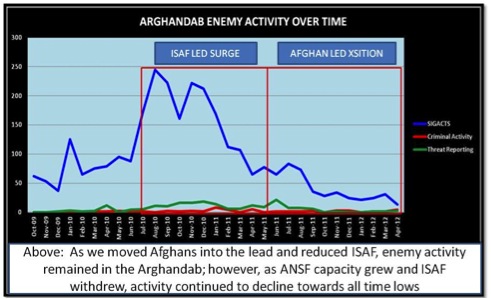
As You Assume an Afghan-Led Posture to Prepare for Transition, Continue to Improve Security and Continue to Improve the Capacity and Capability of the Security Forces. For Arghandab District, the reduction of enemy activity in the area presented the entire formation with a unique opportunity. Absent the energy of absolutely every patrol being focused on combating the enemy, we focused our remaining energy on improving the Afghan Security Forces. Once the fighting season concluded, the Battalion re-doubled its efforts, focusing nearly all energy on training and enabling the Afghans. Only a small percentage of our patrols were dedicated to something other than strengthening governance or strengthening the security apparatus of the District. While we focused on enabling the Afghan security forces, we learned several valuable lessons that many future units should be able to easily embody. Senior leaders must realize that training the ANSF takes time and resources. They should not be concerned about the lack of offensive operations being conducted, particularly when the enemy situation does not call for a volume of kinetically focused operations. When the level of violence is low enough for the government to maintain legitimacy, maintaining an enemy-focused posture crowds out our capacity for building the ANSF.
Observations and Lessons Learned for Follow On Units:
-
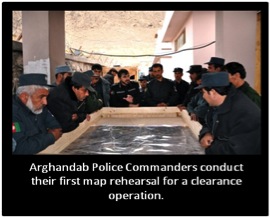 Focus on leadership first. Afghan leaders constitute the future of the nation of Afghanistan. Training and development of Afghan leaders quickly became the most effective way to overcome capacity issues or organizational learning issues. While we trained every Afghan National Army squad how to conduct a squad live fire exercise, the most effective exercises were those where we taught the Afghan leaders the task and then encouraged them to teach their Soldiers. The training of the AUP primary staff (S1, S3, criminal investigator, etc) resulted in significant gains in capacity at the District level.The training of the ANA Battalion primary staff resulted in a full Battalion staff that understood how to run a tactical operations center.The training of police checkpoint commanders resulted in better disciplined policemen.When we focused on training Soldiers, it was still effective – but not nearly to the extent that it was when we focused on leadership first.
Focus on leadership first. Afghan leaders constitute the future of the nation of Afghanistan. Training and development of Afghan leaders quickly became the most effective way to overcome capacity issues or organizational learning issues. While we trained every Afghan National Army squad how to conduct a squad live fire exercise, the most effective exercises were those where we taught the Afghan leaders the task and then encouraged them to teach their Soldiers. The training of the AUP primary staff (S1, S3, criminal investigator, etc) resulted in significant gains in capacity at the District level.The training of the ANA Battalion primary staff resulted in a full Battalion staff that understood how to run a tactical operations center.The training of police checkpoint commanders resulted in better disciplined policemen.When we focused on training Soldiers, it was still effective – but not nearly to the extent that it was when we focused on leadership first.
-
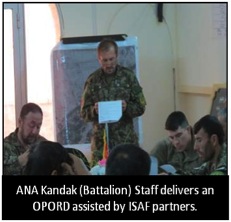 Institute a multi-echelon training mentality. In order to enable the Afghans to assume the lead for security operations in the midst of combat, we were not afforded the luxury of being able to train each echelon incrementally. Squad leaders partnered with Afghan Army squad leaders. American Company Commanders trained Afghan Company Commanders. The entire CTF 1-67 staff was ordered to spend no less than three hours per day mentoring their Afghan Army Battalion counterparts. The battalion dedicated entire platoons to mentoring police checkpoint commanders. In the end, every Afghan leader at every echelon of command - in every formation -had an ISAF counterpart who focused on teaching him his duties and responsibilities.
Institute a multi-echelon training mentality. In order to enable the Afghans to assume the lead for security operations in the midst of combat, we were not afforded the luxury of being able to train each echelon incrementally. Squad leaders partnered with Afghan Army squad leaders. American Company Commanders trained Afghan Company Commanders. The entire CTF 1-67 staff was ordered to spend no less than three hours per day mentoring their Afghan Army Battalion counterparts. The battalion dedicated entire platoons to mentoring police checkpoint commanders. In the end, every Afghan leader at every echelon of command - in every formation -had an ISAF counterpart who focused on teaching him his duties and responsibilities.
-
 Help them work through their problems. With only a small percentage of military aged males with any formal education, the ability of the average Afghan leader to address his own problems is significantly less than it is with our forces. This doesn’t mean they lack the intelligence to execute. It means that our leaders must be able to see past these shortcomings and take the time to teach them. When they need water, don’t simply give it to them…help them figure out a way to get it themselves. When they can’t do more than one patrol a day…teach them how to manage a patrol schedule. When they don’t understand the dangers posed by IEDs…conduct C-IED training with them. Our forces must take on a coaching and teaching mentality at all levels and must not be so quick to judge ANA Soldiers or leaders for their shortcomings. In the words of my Afghan National Army counterpart, “Our Army is only 10 years old, and we have a lot of problems. How many problems did the American Army have when it was only ten years old? We need your help learning…not fighting.” Personally, I thought that was a great way of putting their viewpoint into context.
Help them work through their problems. With only a small percentage of military aged males with any formal education, the ability of the average Afghan leader to address his own problems is significantly less than it is with our forces. This doesn’t mean they lack the intelligence to execute. It means that our leaders must be able to see past these shortcomings and take the time to teach them. When they need water, don’t simply give it to them…help them figure out a way to get it themselves. When they can’t do more than one patrol a day…teach them how to manage a patrol schedule. When they don’t understand the dangers posed by IEDs…conduct C-IED training with them. Our forces must take on a coaching and teaching mentality at all levels and must not be so quick to judge ANA Soldiers or leaders for their shortcomings. In the words of my Afghan National Army counterpart, “Our Army is only 10 years old, and we have a lot of problems. How many problems did the American Army have when it was only ten years old? We need your help learning…not fighting.” Personally, I thought that was a great way of putting their viewpoint into context.
- While Soldiers Focus on Tasks, Leaders Focus on Systems. Three months into our rotation, as we had begun to train the Afghan security forces, the Afghan National Army Battalion Commander once again came to me. “We don’t need your help with just the little things. We need help getting our systems running. We need to learn how to run this Battalion.” Again, another great point. Too often, we want to teach them about leadership in the abstract sense of the word. They already know how to lead their own Soldiers. What they lack are the mechanisms for the stability and predictability that allow them to EFFECTIVELY lead their soldiers. How effective would our formations be if food showed up late everyday? How effective would our formation be if there was no system for getting fuel. Expecting more from the Afghans without putting systems in place to allow them to employ and operate their forces effectively and efficiently, is short-sighted and unrealistic. So, for both the AUP and ANA, we focused on their logistics system, communications system, and intelligence and operations systems. CTF 1-67 Law Enforcement Professionals (LEPs) focused on investigative systems. Our S-2 staff focused on the NDS system. Our S-3 focused on managing both AUP and ANA operations. Every time we focused on enabling their systems to operate, we witnessed drastic improvements in performance.
-
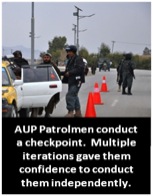 Building confidence is just as important as enhancing competence: It had been 30 years since the Arghandab government possessed a legitimate police force, sponsored by GIRoA, and capable of combating internal threats. It had also been that long since Afghanistan had an Army in which it could take pride. Simultaneously, the brutal allure of the Taliban maintains a psychological hold over the population that degrades the confidence of local citizens as well as that of the Afghan police and soldiers. As a result, the Battalion initiated several initiatives that helped build their confidence through training. However, we conducted tactical operations many times for the sole purpose of enhancing the confidence of all parties in the strength of the Arghandab people as well as its security forces. Clearance operations, long range reconnaissance operations, counter-IED operations, and engagements of the population by the ANSF; all helped alleviate the fear of the Taliban, and helped enhance the confidence of citizens and security forces. While some would think that the pace of operations decreased during this phase, the fact of the matter is that the pace increased substantially with less ISAF involvement. In the end, the Battalion not only put an Afghan face on our operations, but we also went so far as to re-introduce the Afghan face as the permanent solution to creating the confidence needed in the GIRoA.
Building confidence is just as important as enhancing competence: It had been 30 years since the Arghandab government possessed a legitimate police force, sponsored by GIRoA, and capable of combating internal threats. It had also been that long since Afghanistan had an Army in which it could take pride. Simultaneously, the brutal allure of the Taliban maintains a psychological hold over the population that degrades the confidence of local citizens as well as that of the Afghan police and soldiers. As a result, the Battalion initiated several initiatives that helped build their confidence through training. However, we conducted tactical operations many times for the sole purpose of enhancing the confidence of all parties in the strength of the Arghandab people as well as its security forces. Clearance operations, long range reconnaissance operations, counter-IED operations, and engagements of the population by the ANSF; all helped alleviate the fear of the Taliban, and helped enhance the confidence of citizens and security forces. While some would think that the pace of operations decreased during this phase, the fact of the matter is that the pace increased substantially with less ISAF involvement. In the end, the Battalion not only put an Afghan face on our operations, but we also went so far as to re-introduce the Afghan face as the permanent solution to creating the confidence needed in the GIRoA.
When Transition Begins at the Battalion Level it Only Creates a “Bubble” of Security – The Entire Process Must be Synchronized at All Echelons to Enable True Success: As we moved forward with efforts to place the Afghans in the lead in the Arghandab District, the ISAF Soldiers in the region began to realize that we couldn’t possibly fix all of the problems faced by the local population at our level. I heard many different leaders in RC(S) state during my time, “If I were able to place my area on an island, we could fix this, but I can’t. There are so many external factors at play - sanctuaries in Pakistan, problems with GIRoA, etc - that we constantly fight against these problems as well.” The Arghandab serves as a great example of the challenges faced by multiple Districts in the coming months…all external challenges that require the assistance of Afghan leaders at higher levels. The following are a few examples that continue to challenge the Arghandab leadership to this day:
- Afghan National Army sustainment cannot keep pace with the mission demands of the force
- Afghan Uniformed Police sustainment does not provide the daily consumable resources (primarily fuel) needed to keep the police running.
- The District Government lacks any substantial operating budget that allowed the Ministry Representatives to effectively deliver services to the population
- The key insurgent actors which influence Arghandab District continue to reside sanctuaries
These are just small examples of challenges that confront the Afghans on a daily basis. Without fuel, the police will either not patrol or they will begin to tax the population for the funds required to operate – both unacceptable answers given our population-centric COIN focus. Without an operating budget, the District Government faces challenges in delivering on services to the population. Without strategic pressure on Pakistan sanctuaries, key influencers continue to attempt to degrade the security situation. These problems cannot be solved within the District. They must be solved at multiple echelons in a synchronized manner by Afghan leaders…with ISAF assistance where possible.
During Transition, Don’t Stagnante: Ten years into this conflict, I personally can’t count the number of individuals that told me during my time in Afghanistan, “Listen, talk to me about specifics. Don’t talk to me about concepts. I’ve been doing COIN operations for ___ years, and I understand how to do this. I want to know specifically what we need to do to fix this.”
Well, my very last point on enabling the transition of Afghans into the lead role would simply be an answer to these types of statements. That is – if you truly understand COIN doctrine, then you should know that this is a decentralized solution with centralized effects. Putting Afghans in the lead is a critical step in a process that must occur at the local level (and ultimately at the higher echelons) in order to be truly successful…in order to be more than just a public affairs campaign. There are no ‘cookie-cutter’ solutions. You have to be smart enough to apply local solutions at the lowest levels while simultaneously enabling the overall government to create the popular support needed for long term success. Any systems-based approach, metric driven methodology, or other approach to transition that takes the population out of the equation and attempts to induce specific “single approach” solutions that apply in each village, is doomed to failure. As leaders, we need to be careful that our thought processes don’t stagnate simply because we’ve ‘been there…done that’. Leaders who want to solely rely on - rather than capitalize upon - their past experiences, risk not only alienating their own ISAF subordinate elements by not understanding the challenges they face, but they also risk alienating the Afghans by proposing solutions that do nothing to solve the real challenges they face on a daily basis at the local level.
 If you’re not working personally with the local citizens, then your primary focus should be on getting the government to function sufficiently enough to gain the support of the locals. That means mundane areas - delivery of government services, budget execution, Afghan-led infrastructure development processes, enhancing the sustainment capacity of the ANSF, garnering the political support of Provincial and National level key influencers, increasing the popular support for Provincial and National level government officials - all need to become a primary area of emphasis. If the lower echelons can figure out the local and District level grievances, and higher echelons can enable the overall system to work, GIRoA will succeed thanks to the popular support of its citizens. If either echelon fails, the ultimate collapse of security with the Arghandab District, as well as with greater Afghanistan, is a possibility. The Afghans within the Arghandab District have assumed the lead for security and governance. Whether or not they succeed at this point will be determined primarily by the ability of the Provincial and National level entities to garner the popular support (both externally and internally) they require to synchronize the ultimate transition of both the District and Kandahar Province.
If you’re not working personally with the local citizens, then your primary focus should be on getting the government to function sufficiently enough to gain the support of the locals. That means mundane areas - delivery of government services, budget execution, Afghan-led infrastructure development processes, enhancing the sustainment capacity of the ANSF, garnering the political support of Provincial and National level key influencers, increasing the popular support for Provincial and National level government officials - all need to become a primary area of emphasis. If the lower echelons can figure out the local and District level grievances, and higher echelons can enable the overall system to work, GIRoA will succeed thanks to the popular support of its citizens. If either echelon fails, the ultimate collapse of security with the Arghandab District, as well as with greater Afghanistan, is a possibility. The Afghans within the Arghandab District have assumed the lead for security and governance. Whether or not they succeed at this point will be determined primarily by the ability of the Provincial and National level entities to garner the popular support (both externally and internally) they require to synchronize the ultimate transition of both the District and Kandahar Province.
Note: The photos and figures in this essay were provided by MAJ Wyszynski.
About the Author(s)
Comments
Afghans leading has always been the goal. As it should be. However until we acknowledge some basic truths, we are going to have nothing but problems. I think the authors actually believe that a fully functional western style army can be built in Afghanistan. I think that is far too optimistic a veiw, given the last 12 years (frankly, I doubt that we will see it in our lifetime). It will take them generations, to build that kind of force. We need to stop wasting time, resources etc, thinking we can get them to a "Tier 1" force and get them to the bare minuimum level and able to operate competently, nothing more.
One of our biggest problems is that we cannot see any other way but our own. This stems, I believe from our "top down" model, where unless a general (or one of his select minions) comes up with an idea, etc, then it is impossible. We have got to realize that from the smallest of tasks to the grandest of campaigns, there has always been more than one way. If we want to get the Afghans into the lead, we are going to have to step back and realize there is more than one way to skin the cat. We should try to get them to agree to a left and right limit and then let them struggle thru it. I liken this to something I do with Soldiers. I give a task or mission and a time to be complete (time extentions can be asked for based on unforseen factors), next I set a left and right limit. Lastly I make myself available for advice, answer questions etc. Then I let them do it, any way they want as long as it does not, break a law or regulation, is ethically sound and is reasonably safe. Other than that if the task or mission is accomplished, and was legal, what do I care how they do it? They will learn and apply what they learn the next time, without a formal AAR. At the end I do hold an AAR though and offer advice. Which is alot more effective once they have struggled thru something than me standing in front preaching the answer. Offer and provide advice when asked, support when we have to. Stop with buzzwords, "build capacity???" you will just confuse them... We are not going to get them to the level of a western army in the time frame allocated. We need to get them to the bare minuimum level required to do the base job, and no more.
We can set the conditions for a more professional force in the future, with the understanding that it is going to take decades, if even then and there will always be competing factors that are going to affect this in ways we would not dream of in the west. Additionaly force structure, design, skill sets etc, may not fall into line with what we have based of forces on... This dosn't make it wrong.
We have to get them to a base set of core set of capibilties and compentencies... And that shouldn't be a big list. They are not going to have the "flex" that the US and western allies have been able to bring to the fight.
We have got to come up with a limited list of "What does the Afghan Army need to be able to do?" (my stab at it, clearly there is more that must be added, but we have to keep it to the most basic level possible)
1. Secure it's borders.
2. Conduct cordon and search to BN level
3. Conduct raids to BN level
4. Conduct patrols (mounted/dismounted)
5. Feildcraft (landnav, radio use etc)
6. Conduct CASVAC
7. Humaniterian missions
8. intel/counter intel operations
9. TCP and limited lawenforcement
What does the Afghan Army Leadership need to be able to do? (my stab, but stop trying to get them to understand Mission Command, Sun Tsu etc)
1. Lead: Provide it. From TL to Corps Commander duties and responsibilities? How accomplished?
2. Conduct planning: Troop leading procedures, WARNO, FRAGO, OPORD then how they execute those plans.
3. Organize: Task organization (may not be like ours) resources etc
4. Maintain: Equipment, forces training levels etc
5. Communicate: They need good, reliable commo and need to know how to use it effectively.
6. Synchronize: Times, resources and at multiple echelons
7. Provide purpose: Why are we relevent? Where do we fit into the scope of the nation.
Yes there are a ton of implied tasks, but with these guys they cannot be implied.
Addionally the entire organization should be built on a basic BN framework. They need an S-1, S-2, S-3, S-4 and S-6. Everything rolls into these. We have got to keep it simple, working groups, agencies, etc are a no-go. They just cannot handle it.
Next we need to stop telling them how we do it and figure out what type of force THEY want. Do they see a need for a strong NCO corps? We do, they may not. Sure we can and should try to influence them. But cannot make them want what they don't. On the flip side, we shouldn't sell them state of the art equipment, because they are not a state of the art, force. So likely this will limit the Air-Force to cargo, MEDIVAC and recon.
We have got to make the most of the resources they have, not the one they don't and are not going to be able to sustain without us. Building a 10 million dollar police station, isn't going to do them a bit of good, they have not the resources to maintain it, nor education to run it. However providing them with good transport and 5 years worth of spare parts would be good.
COIN works really well when the people agrees and the enemy supports it. Afghanistan, isn't an area that it's going to work. Some parts of it, yes we will have to do, BLUF: The enemy in Afghanistan are essential school yard bullies... And the best way to deal with a bully is to put the wood to them... Instilling abject fear.
In my opinion, your observations are spot on. While 'our' counterinsurgency efforts may have been synonymous with theirs in the Arghandab District, this is not the case everywhere. In fact, this is not the case in quite a few areas.
Over the long haul, the mission must become theirs instead of ours. The primary question becomes, "If our mission doesn't become theirs, then where does that leave us at the end of the day?" We cannot expect the mission to become theirs and automatically expect them to adopt our viewpoints or objectives. Their approach will differ in many ways. Putting them at the forefront implies empowering them with additional burdens and responsibilities. What they choose to do with that power and responsibility in the end is secondary to the notion that it becomes 'their problem' over time.
Looking at this sentence:
"Others continue to wrestle with ‘how’ to place them at the forefront of our counterinsurgency efforts."
I have to wonder if part of the problem is summed up in the desire to place "them" at the forefront of "our" efforts. As long as the efforts are "ours", it's going to be difficult to get "them" into the forefront. Perhaps what's needed is for the missions to become "theirs", instead of "ours". Of course if that happens the missions may no longer entirely suit us, but that possibility is an implicit part of putting "them" in the forefront. If we're the ones deciding what must be done and how it should be done, no amount of rhetoric is going to obscure the reality that we're the ones in the forefront and "they" are following along.
Gentlemen - As to your first paragraph, you could not be more correct. Your point reinforces the notion that these efforts must by synchronized at multiple echelons - just as we pointed out. We have identified weaknesses at various echelons - just as you point out above. The question becomes, "If this synchronization does not occur and the multi-echelon approach is successfully achieved, then what becomes of areas like Arghandab when un-sychronized efforts manifest themselves at the tactical and operational level?"
As to your second point that the people are of secondary concern, I would pose that if the locals had a unifying structure or leader around which to rally (such as this particular District had inherent in the leaders selected), that the loyalty of the average citizen could become a secondary objective for ISAF and ultimately become a primarily GIRoA problem set that they managed. However, in this case, their social structure has been eroded by decades of war to the point that the Afghan people, as a whole, lack any semblance of leadership capable of achieving popular support of the government without force. Given the lack of leadership, and given lack of a negotiaating/political mechanism popularly accepted by it's citizens, we must rely on the ability of the current Afghan leaders to chart their own course with their people. In short - transition to a GIRoA led institution must happen soon..if we expect long term success to begin. The Afghan leaders much be forced to figure out what they need to do next to maintain the structure, and their society must begin to grow again. Should they choose that the GIRoA structure is secondary to other concerns, that decision will have consequences manifested by their actions alone - but the people and their legitimate/illegitimate leaders will make that choice.
Finally, as to your assertions of extreme force, I cannot professionally agree with that particular point. NATO/ISAF could have never achieved many of the objectives that we have reached today with the application of extreme force. There is a time and place for force, and in this environment, at this time, it is not our call to make. Should the Afghan leadership choose to apply extreme force to defeat insurgents, that will ultimately be their decision. However, in this case, in this environment, only the Afghan leaders can make that decision. We do not have that luxury.
Ultimately, our question becomes, based upon your point, if the Afghans choose to resort to more violent methods to quell the insurgency within their own borders, what effect will this have on international support and the mechanism that continues to sustain the country even today? While force may be a mechanism to quell a developing insurgency, it is not a method for achieving long term effects among the very people whose support you are trying to solicit in the first place. Without both popular support and support from the international community, Afghanistan will constantly find itself on the brink of collapse upon the departure of international forces.
In the end, there are no easy answers. In Arghandab, this process of transition worked because of the Afghan leaders and their ability to rally the population - as frustrating as that was at times. Without those leaders, unifying the people, the progress we witnessed within the Arghandab could not have been achieved - and that is a lesson to apply anywhere else - at any time - in a true COIN fight.
The fact of the matter is that "we" don't need to win over the support of the Afghan people. GIRoA, however, must win their support in some way shape or form - or eventually fail. Whether their selected method of winning that support is commensurate with our efforts remains to be seen.
First, I'd like to submit that no amount of "transition" at the tactical level will work in our eyes until the GIRoA- and specifically I mean the MoD and MoI and the President- takes the lead on the effort. We will really never know what they have in mind- what their priorities are and how they want to execute this effort until they do so- and so far I submit they have not. Once that happens we'll see which of our efforts- if any- last beyond our overt presence. I have my own theories, but my point is that transition at the tactical level possibly will mean nothing because GIRoA has a different take on how things should be prosecuted. IMO we should transition to GIRoA lead FIRST- then assist them at the tactical and operational levels to meet GIRoA's plans (the GREAT, BIG, assumption being that their plans will match with our objectives...).
Lastly:
<em>"Anyone who has studied counter-insurgency operations understands that they always come down to a contest for the loyalty of the local population"</em>
I have studied COIN ops and I have come to a different theory than the COINventional wisdom that we should fight over the people. First, I don't think "the loyalty of the locals" always synchs with our national security. Second, I don't think "the people" have the requisite power to mean anything in all times and in all places. Lastly, in my studies I have come to the conclusion that normally most insurgencies were successful to the extent that those they were intent on overthrowing or replacing avoided extreme force. Now, admittedly we can't do that today- and haven't been able to do that since about the late Fifties or maybe more recently- and the fact that most studies only look at the last 50 years or cherry pick history doesn't help much- but I do NOT think it is helpful for us to use these assertions without more questioning of the conventional wisdom.
Instead, I would submit that we will never win over the loyalty of the population in Afghanistan and it is very doubtful if we will assist GIRoA in doing so (assuming it is possible that GIRoA can). I think it would be easier to convert all citizens of Columbia, SC into FSU fans. That we assert without even thinking that us assisting GIRoA to win loyalty is feasible is a very sad sign of our institutional lock-step intellectual atmosphere IMO.
Instead, I would assert something far different: that we must transition to GIRoA lead first. Then, and only then, will we know what the effort will be after 2014. Then we can determine whether their efforts will synch with our objectives. If they won't, we must attempt diplomacy to change their efforts. If they will, then we can get down to the business of assisting them at the tactical and op levels to accomplish what GIRoA wants to do. To assume they want to do what we want is foolish IMO.
